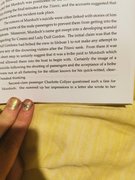Let me explain. I have been interested in this Officer shooting/suicide incident for almost 35 years and have tried to research into it as much as my spare time allowed. I did not start out with any preconceived notions or hero worship but tried to look at it in an objective way. I thought that I was sharing a bit of sarcasm with you about others' statements that Murdoch could not have committed suicide because he was a hero etc. Clearly, I did not phrase it properly but I am sure you know what I meant now.
I agree that
On A Sea of Glass is an excellent book and also that based on the detailed analysis therein, we have to accept that an officer shooting/suicide probably did take place. I am not disputing that part but the general assumption that Murdoch must have been the officer involved based on what appear to be survivor statements quoted in your link; those in turn led to further blanket statements in some books and culminated in James Cameron's film. Thus, Murdoch was placed in that seemingly unshakable position and still seems the most "popular candidate" for the misadventure. THAT is what I strongly disagree with because as I have shown in post #23 of this thread,
none of those witnesses who named Murdoch as the officer involved were actually in a position to identify him and none of the witnesses who were actually in a position to identify the officer involved, named Murdoch.
My interest in the shooting incident began in 1985 with a chance meeting of a woman named Alice Braithwaite, who was the niece of a man named Clarence Woods, a wartime friend and fellow POW of John Collins, the scullion who survived the
Titanic disaster as a 17 year old. Collins did
not know Murdoch personally of course but was aware of the First Officer as the only Scottish officer on board. If you are British, you should know what is true even to this day - in an English majority crowd, non-English Brits like Scots, Welshmen and Irishmen tend to be more 'aware' of each other even without meeting and irrespective of rank or social position. I suppose Murdoch's strong Scottish accent would have been familiar to almost everyone who encountered him on board. John Collins certainly appears to have been able to recognize Murdoch easily and did so during the final moments of the
Titanic's sinking that night in the vicinity of Collapsible A. Collins first discussed this with Woods when they were fellow POWS in Germany during WW1; after the war Collins visited Woods and that was where a very young Alice appears to have met the scullion. Apart from Mrs Braithwaite, I have written and spoken to Mary McKee, Collins' daughter. Mrs McKee herself did not have a great interest in the
Titanic and was quite young when her father died. But she certainly recalled her father discussing this at length with her older brother, who was very interested. She recalled enough to tell me about her father John Collins witnessing the shooting incident but that appeared to be at least a few minutes
before he tired to help, unsuccessfully as it turned out, a woman (probably Anna Palsson) and her baby to reach Collapsible A. It was during that chaotic period that he also saw the Scots officer knocked overboard, something that Lightoller reportedly also saw from a different vantage point.
When I communicated with Mrs McKee in 1990-91, she did not communicated with her older brother for many years but knew he was still alive and living somewhere in America. I did try to trace him based on the information she gave me but with my limited resources and work pressures, I did not make much progress and by 1995 was forced to give-up.
Meanwhile, there were other sources and speculations. As you know, in his 1986 book
The Night Lives On,
Walter Lord alluded to the shooting incident in the chapter "Shots in the Dark" and later considered the possibility that it might have been Murdoch. But by the time he was part of a live TV interview in 1989, Lord seemed to have changed his mind and opined that it was actually Wilde. As far as I know, Lord did not elaborate why he was thinking on those lines.
In the ensuing years I have used resources like ET,
On A Sea of Glass etc and collated the information available including witness statements. That was what we discussed above and when one looks at the possibilities on
both sides, you have to admit that the Murdoch candidacy becomes highly unlikely. I want to also point out that I have no personal reason to shift that 'candidacy' from Murdoch to Wilde; just that
Walter Lord for reasons not revealed AFAIK, seemed to think that way; also, survivors Carl Jonsson and John Collins, who were close enough to have seen what happened, suggested it was Chief Officer (Wilde). That is just a statement of fact and I am not going to speculate further on it, at least not in this thread.


